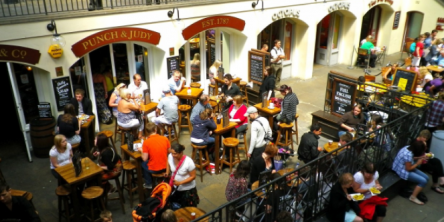5 Ways AI is Improving the Restaurant Industry

AI is rapidly changing the way things work, how they work and how much we work as a result. It is gradually becoming a part of every industry and integrating these technological advancements will soon become the norm. While the media and popular culture often paint an insidious man vs robots picture, in reality, AI has many upsides and is already proving to be hugely beneficial for businesses. In particular, it will play a key role in stimulating growth by increasing sales, boosting productivity and improving customer satisfaction. Its expected impact was corroborated by a recent Mckinsey Global Institute (MGI) discussion paper, that explored the huge global effect AI will have on the global economy. They projected that it could help to generate an additional $13 trillion by 2030, boosting global GDP by about 1.2 per cent a year.
AI is already making huge waves in the restaurant industry and transforming the way it operates. Many well-known corporations have started adopting the latest innovative technologies and are using them to improve customer service, cut costs, streamline their operations and automate manual tasks for speed and efficiency. Here are some of the most interesting and innovative ways AI is being used to improve the efficiency of the restaurant industry.
1) Virtual Assistants to Boost Sales
According to statistics, people now check their phone every ten minutes and spend 90% of that time in messaging and social media platforms. This rise in social media use has meant companies need to establish and maintain a strong presence on these platforms while thinking about ways they can tap into their following to boost sales. To achieve this, an increasing number of companies are now using tools such as chatbots and Domino’s success story is a great example. The companies bot “Dom” was created by enhancing their Facebook Messenger chatbot to incorporate AI technology that can take customer orders using conversational technology. Its interface also allows customers to browse the menu and pay without needing to leave the bot. While there are no specific statistics available, in 2015 the company attributed a staggering $4.7 billion in “global digital sales” to its investments in implementing innovative technology. Other companies following suit are chains such as Subway, TGI Friday, Starbucks and Burger King who aim to capture a generation that now prefers digital communication over more traditional methods. Bot technology is advancing at such a rapid rate it can now upsell food pairings, recommend different food options, answer questions and engage in general chat and make jokes, almost as you were talking to a friend!
2) Personalised Solutions at Drive Throughs
Drive-throughs have always been a popular way to order food and have been undergoing some dramatic changes in recent years. To keep up with an evolving market and customer demands, companies are now implementing forward-thinking solutions in a bid to simplify ordering and offer a faster, more efficient and personalised service. One example of this is McDonald's, who recently acquired Dynamic Yield, a company that specialises in customer personalisation. Using their expertise, they rolled out an initiative to install menus offering customers personalised recommendations at drive-throughs across the United States. The menus on display have the ability to change depending on the time of day, weather, current restaurant traffic and trending menu items. After the success of the initial pilot, they now plan to incorporate the technology into all of its digital platforms, which includes in-store self-order kiosks, its mobile app and at other drive-through restaurants in the US.
In 2018, the company Encounter AI created Mai - dubbed the worlds the world's most advanced voice ordering assistant for retailers and restaurants that also provides accessibility for the blind. Mai is being installed at drive-throughs across the U.S. and has the capability to take orders, connect to their point of sale system and answer customer questions. It is fully customizable and allows establishments to change their tone and style to keep in line with their brand identity. Mai uses advanced machine learning that remembers customer preferences and is then able to offer them targeted products on future visits. Encounter AI believes Mai will help to free up staff members time as well as cut burgeoning labor costs, creating a more cost-effective, fast and efficient service.
3) Customer Facial Recognition
It may sound like something out of a movie, but facial recognition is here and is already being used in the restaurant industry. KFC recently joined forces with the Chinese company Baidu and began developing AI facial recognition technology that has the power to anticipate what a customer may order based on demographics and biological features such as gender, facial expressions and other visual determinations. It works by scanning customers faces and offering a menu item based on their individual characteristics. Another potential way this technology may be used is for improving loyalty programmes. Consumers often leave their loyalty cards at home, don’t bother to download loyalty apps or just can’t find the time to signup in the first place. This means they lose out on loyalty points and benefits, while restaurants are missing out on gathering valuable marketing data. Facial recognition has the potential to revolutionise loyalty programmes by mitigating these problems. By scanning customer faces, details of their purchases, preferred payment methods and loyalty points can easily be accessed. Other companies such as CaliBurger in California are now allowing customers the option to pay for their meal using face-based recognition technology. This type of technology is still in its infancy but could soon be adopted more widely by a number of companies.
4) Robotic Restaurant Servers
Some companies have taken this a step further by bringing their AI to life. Mastercard recently collaborated with Japanese technology company SoftBank to produce a humanoid Robot server named Pepper. She is able to process orders, can give recommendations and process Mastercard payments. Pizza Hut has since followed the trend and purchased Pepper robots, emphasising that they make payments easier and more secure. Although Pepper still has limitations and humans are still needed to bring actual food orders to customers. Which is what company Bear Robotics aims to eliminate. They have developed robots who have the capability to deliver food directly to customers tables. While they still aren’t able to provide the same level of human customer service, the company is working towards offering a more human experience by programming them to be courteous, helpful and friendly. Companies are moving towards integrating them with more traditional systems such as restaurant paging systems, that will successfully streamline their operational capacity.
5) Self-Ordering Kiosks
Possibly the least futuristic of all AI developments is the move towards self-ordering kiosks. McDonald’s has been one of the innovators in this space, with plans to install them at 20,000 of their restaurants this year. They will work in conjunction with their mobile payment app allowing customers to avoid long lines and benefit from faster service. This will also allow them to collect valuable data on customers which can be used to drive their marketing efforts and increase sales.
Similar Articles
Discover the top 15 post-workout snacks that energize and nourish your body. Fuel your fitness journey with these delicious and nutritious snacks.
Energy supplements are more popular than ever because more men are substituting endurance sports like trail runs, marathons, and triathlons for gym time. But what precisely are they, how do they function, and should you include them in your exercise routine?
We are what we eat. And when we train or wish to be in good health, then the importance of proper nutrition is highlighted tenfold. Quality over quantity is always important when we wish to build our health and bodies
You must be using a cup or mug at least once a day to have your coffee or tea. Also, you might know people who are coffee lovers and always carry a cup with them. When it comes to drinking tea or coffee, most people have ceramic cups.
International dishes are becoming part of the growing foodie trend many people seemingly cannot get enough of. Every week, people tune into their favorite cooking and travel shows to check out the latest culinary delights from locals as well as abroad.
In the past decade or so, healthy eating doesn’t present the palatability challenges it once did. Grittiness, aftertastes, the expense of preparation or driving to the stores that sold these products. Today, many foods like meatless burger patties, vegan egg substitutes, and sugar alternatives cost less than dining out
Winter is a difficult time for bees, especially if their beehives aren’t prepared correctly. This is the time of year when most losses occur. If we take some necessary care in summer and spring, we can be perfectly prepared for the upcoming winters.
On-Demand food delivery has been highly successful during the global pandemic. More and more people prefer contactless food delivery overeating at hotels and restaurants. The demand is so high that food delivery startups are facing tough competition.
Around the world, the UK gets an unfair reputation when it comes to food. Cities like Rome, Paris, Tokyo, and Mexico City are held in high regard thanks to their food scene. Unfortunately for London, there is this outdated stereotype about “awful British food”, often made with snark from the other side of the Atlantic, that has been hard to shake off








